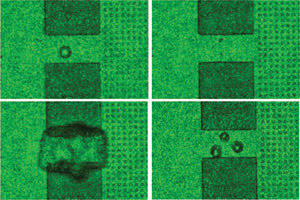Study may have implications for cancer therapy and improvements in ink-jet printer technology.
Anne L. Fischer, Senior Editor
Boiling water was thought to be a well-understood phenomenon until we entered the age of nanomaterials. Now the concept of nanobubbles, which collect on a surface when it is heated to boiling, is under study.
A team from the National Institute of Standards and Technology in Gaithersburg, Md., and from Cornell University in Ithaca, N.Y., reported its work on nanoscale bubbles forming on hydrophilic surfaces in the March 23 issue of Physical Review Letters.
The researchers believe that measuring the lifetimes of these nanobubbles, which they estimated to be approximately 100 μs, may help improve models for optimal heat transfer design in nanostructures. This has application in devices such as ink-jet printers, where a metal film is heated with a high-frequency voltage pulse, creating a bubble that ejects the ink droplet through a nozzle. When ink-jet technology is pushed to greater speeds, it may be difficult to control the bubble formation properly, so the work this team is doing on timing of heat pulses may be beneficial.
Thermal cancer therapy also may benefit because it works by sending nanoscale objects into tumors and heating them remotely with infrared radiation or alternating magnetic fields. Each nanoscale object acts as a heater, and nanobubbles can be created if the objects are heated to the right temperature. It is thought that the bubbles may have a therapeutic effect if additional heat is applied and nanobubbles add mechanical stress to surrounding tissue.
To study the formation of nanobubbles, the team used a laser strobe microscopy technique that included a Q-switched Nd:YAG laser from Continuum of Santa Clara, Calif., with the 1064-nm line frequency doubled to produce a 532-nm beam. A microscope from Nikon of Tokyo was attached to a 100× water-immersion Olympus objective lens, and a Nikon digital camera captured images through the microscope of a platinum microheater surface that was 15 μm wide, 30 μm long and 0.2 μm thick. A digital gate and delay generator was used for coordinating the Q-switch and camera shutter, and a pulse generator triggered an electrical pulse to the heater element. A pulse generator from Agilent Technologies Inc. of Santa Clara, Calif., delivered a programmed voltage to a bridge circuit that heated a platinum film.
A computer running Labview software from National Instruments of Austin, Texas, automated the triggering of the pulse generator that heated the thin film, and a digital oscilloscope from LeCroy of Chestnut Ridge, N.Y., was used to observe and record the waveform of the voltage output from the bridge circuit.
A voltage pulse of 5 μs rapidly heated the water. During this pulse, as the heater heated up, its resistance increased, as measured using the bridge circuit. At nearly 300 °C, a bubble was nucleated. As the pulse continued, the resistance increased at a higher rate. The bubble grew to tens of microns in diameter as characterized by time-lapse movies assembled from the laser strobe microphotographs. When the pulse ended, the bubble collapsed as the temperature fell.
But the researchers found that if they applied a second pulse closely enough, a second bubble was formed at a lower temperature and earlier in the pulse. The photography showed that the nucleation of bubbles now occurred in random locations on the heater. The scientists conjectured that when the heat is turned off, after the first pulse, the bubble collapses yet leaves something on the surface that acts to influence the process for the second pulse.

The top left shows the nucleation of the bubble on the first pulse, which always occurred at the same location on the heater. This bubble grows to span the entire heater area (lower left). The heat pulse is 5 μs long, so when the voltage pulse is turned off, the heater returns to room temperature (as measured by the heater resistance) in a few microseconds, and the bubble collapses (upper right). At 40 μs after the end of the first pulse, the second pulse begins. At this time the heater is at room temperature, and photographs show no bubbles on it. The nucleation now occurs at an earlier time with respect to the start of the heat pulse, and bubbles are observed to nucleate at random locations (lower right).
They believe that the nanobubbles formed by the collapse of the first bubble become the nucleation sites for growth of later bubbles. By changing the timing between voltage pulses and observing the morphology and repeatability of the second bubble, the scientists estimated the lifetimes of the nanobubbles.
The team wants to examine the process of laser irradiation on single-walled carbon nanotubes while they are exposed to a laser of an appropriate wavelength, according to C. Thomas Avedisian, a professor at Cornell. The scientists are interested in measuring the temperature at the level of the single-walled carbon nanotube during exposure to the laser because temperature is the variable that optimizes the pulse energy and duration. Because this technique is applicable to cancer therapies, the goal is to get the highest local temperature at the single-walled carbon nanotubes with the lowest laser power and lowest pulse duration so that healthy tissue is not damaged.
Another subject for future study is temperature oscillations that occur when the pulse is on for a long time. The researchers have been using 5 μs as the “on” time because it correlates to some commercial ink-jet printers, but they are boosting that to tens of microseconds and plan to use the imaging setup to observe bubble morphology during the oscillating phase. They expect that, eventually, a bubble will grow to an observable size.
The research was supported by the NY State Institute of Biotechnology and Life Science Technologies.